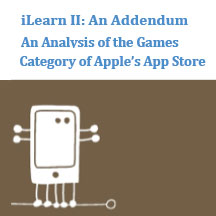Carly Shuler is a researcher, developer, and author in the children’s media and toy industry. As our inaugural Fellow, Carly has researched and authored a number of Cooney Center reports, including D is for Digital, iLearn and Pockets of Potential. Since her fellowship, Carly has continued her work with the Center, leading many of our industry initiatives and research projects with a particular focus on consumer trends, informal learning, and mobile devices.
 When iLearn: A Content Analysis of the iTunes App Store’s Education Section was published in 2009, slightly more than 85 million apps had been downloaded from Apple’s iTunes App store. With successive generations of iPhones and the launches of both iTouches and iPads, the number of downloaded apps has grown exponentially. In the U.S., a quarter of all parents have downloaded apps onto one of these devices for their children. Through the end of 2011, more than 18 billion apps overall have been downloaded; of these apps many were downloaded from the Education category and designed to serve children – ranging from toddlers to high school aged.
When iLearn: A Content Analysis of the iTunes App Store’s Education Section was published in 2009, slightly more than 85 million apps had been downloaded from Apple’s iTunes App store. With successive generations of iPhones and the launches of both iTouches and iPads, the number of downloaded apps has grown exponentially. In the U.S., a quarter of all parents have downloaded apps onto one of these devices for their children. Through the end of 2011, more than 18 billion apps overall have been downloaded; of these apps many were downloaded from the Education category and designed to serve children – ranging from toddlers to high school aged.
Using iLearn as a benchmark, the Joan Ganz Cooney Center undertook a further examination of the Education category within iTunes’ app store and found similar growth within this channel and in the opportunity this presents for educators, developers and teachers to work together to leverage digital media for learning.
Among the key findings of iLearn II: An Analysis of the Education Category on Apple’s App Store regarding this market and its trends were:
– In 2009, almost half (47%) of the top-selling apps targeted preschool or elementary aged children. That number has increased to almost three-quarters (72%).
– Fourteen percent of the apps were tagged for intended school usage. Of the entire sample, only two iPhone apps and no iPad apps were based on well-known branded characters.
– One hundred and nine different publishers were represented within the sample; 89 of these publishers were not represented in the sample 2 years ago.
Based on these findings, many recommendations were made. Primarily though, focused on the following:
- – Manage, to reduce, the ‘app gap’– According to a recent Common Sense Media report, 38% of lower-income parents don’t know about apps, while 47% of higher income parents have downloaded apps for their children. While providing market insight into the current atmosphere, this data indicates an opportunity for producers and educators to address this new ‘digital divide’ to help ensure all children can access these new tools for learning.
- – Create standards for products marketed as educational – No voluntary or regulatory standards currently exist around marketing products as educational. Industry leaders and policymakers should collaborate on developing a voluntary consumer education initiative to improve access to information about apps educational potential, proven impact and age appropriateness.
This report was compiled to provide developers, educators and researchers with tools to address the digital divide and other key concerns as well as optimize existing and new opportunities of this growing and evolving category and its content.




